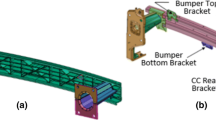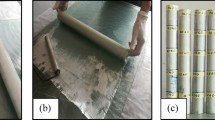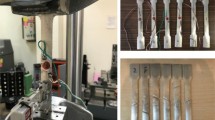Abstract
Background
A novel crash sled has been developed with a translating support incorporating transducers that allow multiple methods of measuring energy absorption to fully characterize the dynamic crush response of composite components.
Objective
The main goal of the current investigation was to demonstrate functionality, repeatability, and accuracy of crush testing using a crash sled with a translating support mass.
Methods
A semi-automated algorithm for data reduction was developed based on impact mechanics principles. A preliminary set of tests was initially conducted using aluminum honeycomb specimens with a specified stable crushing force to quantify the accuracy and repeatability of the crush data. Following the success of these tests, triaxially-braided fiber-reinforced polymer (FRP) specimens were evaluated.
Results
Crush tests with the aluminum honeycomb specimens showed excellent outcomes for all three specimens. These data provided close agreement with cumulative energy absorption between individual instruments and stable crushing forces at expected values. For the FRP specimens, specific energy absorption (SEA) and force-displacement curves were successfully measured; however, data from the translating support mass accelerometer were excluded from the dataset due to clipping. The SEA of the corrugated specimens was greater than the SEA for the C-channel specimens at both test speeds.
Conclusions
The crash sled functionality was verified, the specimen geometry was found to contribute more to SEA than the impact speed in the speed range tested, and the support mass accelerometer will be upgraded to prevent clipping in future tests.






















Similar content being viewed by others
References
Garner DM, Adams DO (2008) Test methods for composites crashworthiness: a review. J Adv Mater 40(4):5–26
Jacob GC, Fellers JF, Simunovic S, Starbuck JM (2002) Energy absorption in polymer composites for automotive crashworthiness. J Compos Mater 36(7):813–850
Thornton PH (1985) Effect of trigger geometry on energy absorption in composite tubes. Fifth International Conference on Composite Materials: ICCM-V, San Diego 1183–1199
Carruthers JJ, Kettle AP, Robinson AM (1998) Energy Absorption Capability and Crashworthiness of Composite Material Structures: A Review. Appl Mech Rev 51(10):635–649. https://doi.org/10.1115/1.3100758
Cantwell WJ, Morton J (1991) The impact resistance of composite materials—a review. Composites 22(5):347–362
Rabiee A, Ghasemnejad H (2017) Progressive crushing of polymer matrix composite tubular structures. Open J Compos Mater 7:14–48
Hull D (1991) A unified approach to progressive crushing of fibre-reinforced composite tubes. Compos Sci Technol 40(4):377–421
Farley GL, Jones RM (1992) Crushing characteristics of continuous fiber-reinforced composite tubes. J Compos Mater 26(1):37–50
Farley GL, Jones RM (1989) Energy-absorption capability of composite tubes and beams. Dissertation, Virginia Polytechnic Institute and State University
Johnson NL, Browne AL (2002) Dynamic crush tests using a “free-flight” drop tower: practical aspects. Exp Tech 26(6):47–49. https://doi.org/10.1111/j.1747-1567.2002.tb00091.x
Browne AL, Johnson NL (2002) Dynamic crush tests using a “free-flight” drop tower: theory. Exp Tech 26(5):43–46. https://doi.org/10.1111/j.1747-1567.2002.tb00084.x
Chou CC, Paluszny A, Clements RR, Mepes DR, Wade AJ (1987) Horizontal impact sled for crash testing of vehicle structures SAE Technical Paper 871948. https://doi.org/10.4271/871948
Banthia N, Mindess S, Bentur A, Pigeon M (1989) Impact testing of concrete using a drop-weight impact machine. Exp Mech 29(1):63–69
Zhou W, Craig J, Hanagud S (1991) Crashworthy behavior of graphite/epoxy composite sine wave webs. Proceedings of AIAA 32nd Structures, Structural Dynamics, and Materials Conference. https://doi.org/10.2514/6.1991-1196
Liu X, Belkassem B, Jonet A, Lecompte D, Van Hemelrijck D, Pintelon R, Pyl L (2019) Experimental investigation of energy absorption behaviour of circular carbon/epoxy composite tubes under quasi-static and dynamic crush loading. Compos Struct 227:111266. https://doi.org/10.1016/j.compstruct.2019.111266
Giavotto V, Anghileri M, Castelletti LM, Milanese A, Manganini DM (2010) A braking system for tests with a prescribed deceleration pulse. Exp Mech 50(7):915–930
Engel-Watzek S, Lukaszewicz D (2015) Testing and comparison of energy absorption for crash tubes with different fibre architectures and matrices. 20th International Conference on Composite Materials, Copenhagen, Denmark, 19–24
Al Galib D, Limam A (2004) Experimental and numerical investigation of static and dynamic axial crushing of circular aluminum tubes. Thin-Walled Struct 42(8):1103–1137. https://doi.org/10.1016/j.tws.2004.03.001
Hou B, Zhao H, Pattofatto S, Liu JG, Li YL (2012) Inertia effects on the progressive crushing of aluminium honeycombs under impact loading. Int J Solids Struct 49(19–20):2754–2762
Brimhall TJ (2005) Friction energy absorption in fiber reinforced composites. Dissertation, Michigan State University. https://search.proquest.com/openview/3f721bcc910e9673de9d65a39b14804c/1?pq-origsite=gscholar&cbl=18750&diss=y
Courteau MA, Adams DO, Starbuck JM (2019) Effects of crush failure mode on energy absorption in carbon/epoxy tubes. SAMPE J 55(2):26–37
Thornton PH, Edwards PJ (1982) Energy absorption in composite tubes. J Compos Mater 16(6):521–545
Feraboli P, Norris C, McLarty D (2007) Design and certification of a composite thin-walled structure for energy absorption. Int J Veh Des 44(3–4):247–267
Abdewi EF, Sulaiman S, Hamouda AMS, Mahdi E (2008) Quasi-static axial and lateral crushing of radial corrugated composite tubes. Thin-Walled Struct 46(3):320–332
Hanagud S, Craig JI, Sriram P, Zhou W (1989) Energy absorption behavior of graphite epoxy composite sine webs. J Compos Mater 23(5):448–459
Farley GL (1991) The effects of crushing speed on the energy-absorption capability of composite tubes. J Compos Mater 25(10):1314–1329
Daniel IM, Ishai O (2006) Engineering mechanics of composite materials (2nd ed). Oxford University Press
Ruggeri CR, Haluza RT, Periera JM, Miller SG, Bakis CE, Koudela KL (2020) Crash sled testing of triaxially-braided cfrp for improved vehicular crashworthiness NASA Technical Report GRC-E-DAA-TN74884. https://ntrs.nasa.gov/api/citations/20200003047/downloads/20200003047.pdf
Han H, Taheri F, Pegg N (2007) Quasi-static and dynamic crushing behaviors of aluminum and steel tubes with a cutout. Thin-Walled Structures 45(3):283–300. https://doi.org/10.1016/j.tws.2007.02.010
Farley GL (1983) Energy absorption of composite materials. J Compos Mater 17(3):267–279
Mamalis AG, Manolakos DE, Ioannidis MB, Papapostolou DP (2005) On the response of thin-walled CFRP composite tubular components subjected to static and dynamic axial compressive loading: experimental. Compos Struct 69(4):407–420. https://doi.org/10.1016/j.compstruct.2004.07.021
Coppola A, Faruque O, Truskin JF, Board D, Jones M, Tao J, Chen Y, Mehta M (2017) Validation of material models for automotive carbon fiber composite structures via physical and crash testing (DOE-USAMP--05661–1, 1395831; p. DOE-USAMP--05661–1, 1395831). https://doi.org/10.2172/1395831
Acknowledgements
The authors acknowledge Allen Sheldon of Honda R&D Americas for guidance in specimen design and test conditions.
Funding
Partial financial support was received from the NASA Revolutionary Vertical Lift Technology Project. The lead author received funding from the Pennsylvania State University Applied Research Laboratory Walker Assistantship Program and the NASA Internship Project at NASA Glenn Research Center.
Author information
Authors and Affiliations
Corresponding author
Ethics declarations
Conflict of Interest
The authors have no conflicts of interest to declare that are relevant to the content of this article.
Additional information
Publisher's Note
Springer Nature remains neutral with regard to jurisdictional claims in published maps and institutional affiliations.
Rights and permissions
About this article
Cite this article
Haluza, R.T., Ruggeri, C.R., Pereira, J.M. et al. Novel Crash Sled with a Translating Support Mass. Exp Mech 62, 715–728 (2022). https://doi.org/10.1007/s11340-021-00812-8
Received:
Accepted:
Published:
Issue Date:
DOI: https://doi.org/10.1007/s11340-021-00812-8




